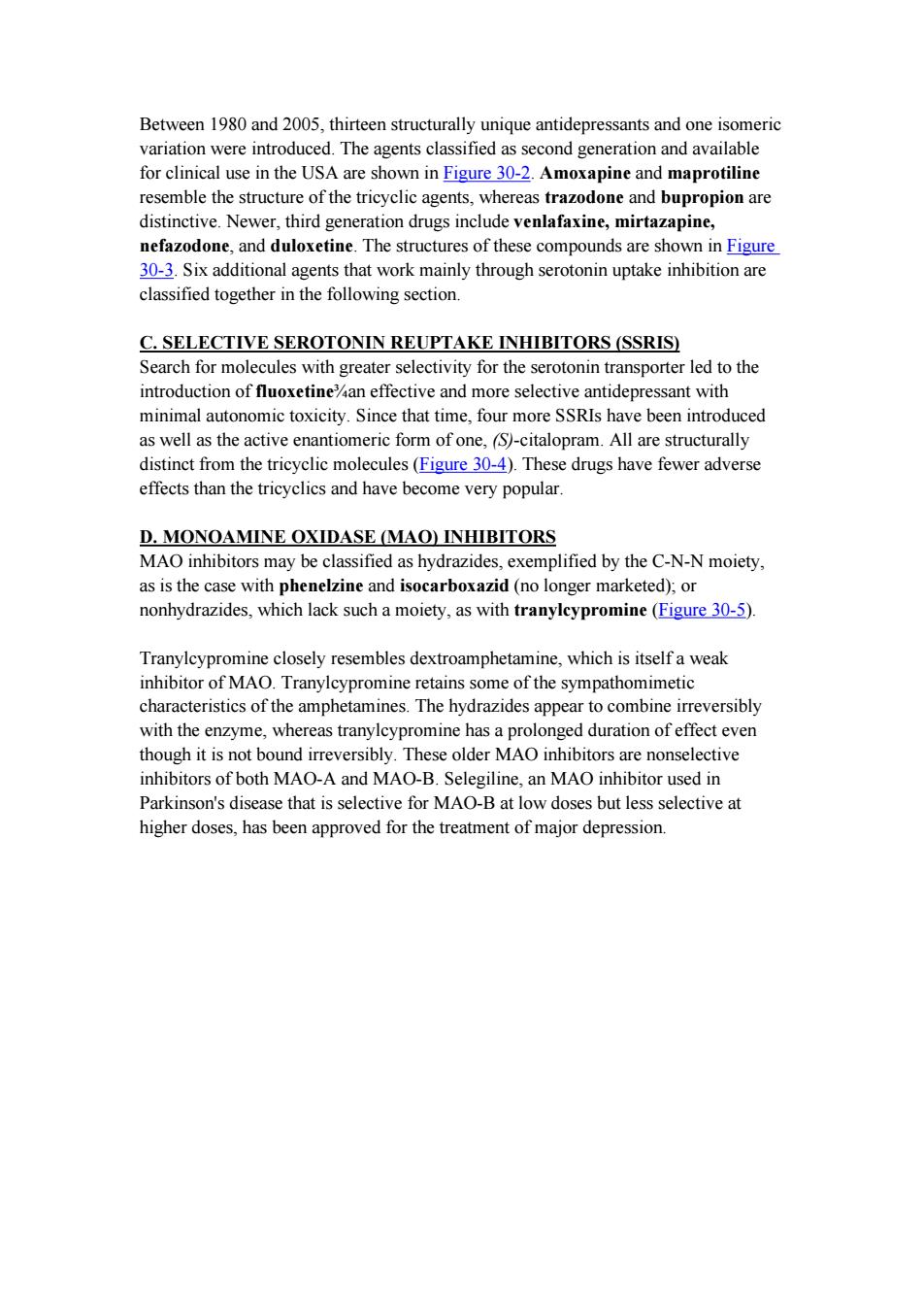正在加载图片...

Between 1980 and 2005,thirteen structurally unique antidepressants and one isomeric variation were introduced.The agents classified as second generation and available for clinical use in the USA are shown in Figure 30-2.Amoxapine and maprotiline resemble the structure of the tricyclic agents,whereas trazodone and bupropion are distinctive.Newer,third generation drugs include venlafaxine,mirtazapine, nefazodone,and duloxetine.The structures of these compounds are shown in Figure 30-3.Six additional agents that work mainly through serotonin uptake inhibition are classified together in the following section. C.SELECTIVE SEROTONIN REUPTAKE INHIBITORS (SSRIS) Search for molecules with greater selectivity for the serotonin transporter led to the introduction of fluoxetine%an effective and more selective antidepressant with minimal autonomic toxicity.Since that time,four more SSRIs have been introduced as well as the active enantiomeric form of one,(S)-citalopram.All are structurally distinct from the tricyclic molecules(Figure 30-4).These drugs have fewer adverse effects than the tricyclics and have become very popular. D.MONOAMINE OXIDASE (MAO)INHIBITORS MAO inhibitors may be classified as hydrazides,exemplified by the C-N-N moiety, as is the case with phenelzine and isocarboxazid(no longer marketed);or nonhydrazides,which lack such a moiety,as with tranylcypromine(Figure 30-5). Tranylcypromine closely resembles dextroamphetamine,which is itself a weak inhibitor of MAO.Tranylcypromine retains some of the sympathomimetic characteristics of the amphetamines.The hydrazides appear to combine irreversibly with the enzyme,whereas tranylcypromine has a prolonged duration of effect even though it is not bound irreversibly.These older MAO inhibitors are nonselective inhibitors of both MAO-A and MAO-B.Selegiline,an MAO inhibitor used in Parkinson's disease that is selective for MAO-B at low doses but less selective at higher doses,has been approved for the treatment of major depression.Between 1980 and 2005, thirteen structurally unique antidepressants and one isomeric variation were introduced. The agents classified as second generation and available for clinical use in the USA are shown in Figure 30-2. Amoxapine and maprotiline resemble the structure of the tricyclic agents, whereas trazodone and bupropion are distinctive. Newer, third generation drugs include venlafaxine, mirtazapine, nefazodone, and duloxetine. The structures of these compounds are shown in Figure 30-3. Six additional agents that work mainly through serotonin uptake inhibition are classified together in the following section. C. SELECTIVE SEROTONIN REUPTAKE INHIBITORS (SSRIS) Search for molecules with greater selectivity for the serotonin transporter led to the introduction of fluoxetine¾an effective and more selective antidepressant with minimal autonomic toxicity. Since that time, four more SSRIs have been introduced as well as the active enantiomeric form of one, (S)-citalopram. All are structurally distinct from the tricyclic molecules (Figure 30-4). These drugs have fewer adverse effects than the tricyclics and have become very popular. D. MONOAMINE OXIDASE (MAO) INHIBITORS MAO inhibitors may be classified as hydrazides, exemplified by the C-N-N moiety, as is the case with phenelzine and isocarboxazid (no longer marketed); or nonhydrazides, which lack such a moiety, as with tranylcypromine (Figure 30-5). Tranylcypromine closely resembles dextroamphetamine, which is itself a weak inhibitor of MAO. Tranylcypromine retains some of the sympathomimetic characteristics of the amphetamines. The hydrazides appear to combine irreversibly with the enzyme, whereas tranylcypromine has a prolonged duration of effect even though it is not bound irreversibly. These older MAO inhibitors are nonselective inhibitors of both MAO-A and MAO-B. Selegiline, an MAO inhibitor used in Parkinson's disease that is selective for MAO-B at low doses but less selective at higher doses, has been approved for the treatment of major depression